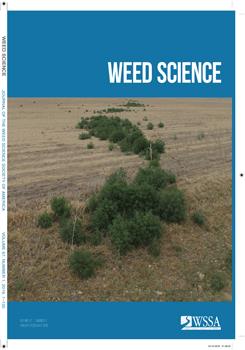Information about weed biology and weed population dynamics is critical for the development of efficient weed management programs. A field experiment was conducted in Fayetteville, AR, during 2014 and 2015 to examine the effects of Palmer amaranth (Amaranthus palmeri S. Watson) establishment time in relation to soybean [Glycine max (L.) Merr.] emergence and the effects of A. palmeri distance from the soybean row on the weed's height, biomass, seed production, and flowering time and on soybean yield. The establishment time factor, in weeks after crop emergence (WAE), was composed of six treatment levels (0, 1, 2, 4, 6, and 8 WAE), whereas the distance from the crop consisted of three treatment levels (0, 24, and 48 cm). Differences in A. palmeri biomass and seed production averaged across distance from the crop were found at 0 and 1 WAE in both years. Establishment time had a significant effect on A. palmeri seed production through greater biomass production and height increases at earlier dates. Amaranthus palmeri that was established with the crop (0 WAE) overtopped soybean at about 7 and 10 WAE in 2014 and 2015, respectively. Distance from the crop affected A. palmeri height, biomass, and seed production. The greater the distance from the crop, the higher A. palmeri height, biomass, and seed production at 0 and 1WAE compared with other dates (i.e., 2, 4, 6, and 8 WAE). Amaranthus palmeri establishment time had a significant impact on soybean yield, but distance from the crop did not. The earlier A. palmeri interfered with soybean (0 and 1 WAE), the greater the crop yield reduction; after that period no significant yield reductions were recorded compared with the rest of the weed establishment times. Knowledge of A. palmeri response, especially at early stages of its life cycle, is important for designing efficient weed management strategies and cropping systems that can enhance crop competitiveness. Control of A. palmeri within the first week after crop emergence or reduced distance between crop and weed are important factors for an effective implementation of weed management measures against A. palmeri and reduced soybean yield losses due to weed interference.
How to translate text using browser tools
1 January 2019
Effects of Palmer Amaranth (Amaranthus palmeri) Establishment Time and Distance from the Crop Row on Biological and Phenological Characteristics of the Weed: Implications on Soybean Yield
Nicholas E. Korres,
Jason K. Norsworthy,
Andy Mauromoustakos
ACCESS THE FULL ARTICLE
<
Previous Article
|

Weed Science
Vol. 67 • No. 1
February 2019
Vol. 67 • No. 1
February 2019
biomass production
fecundity
Flowering
ground cover
integrated management
light interception
phenology





